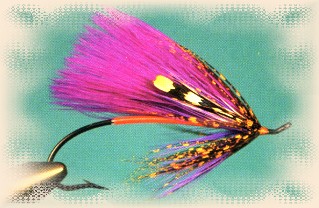Spawning Purple
By John Shewey and Forrest Maxwell
Flies For Summer Steelhead
If we were to assemble one each of every
Steelhead fly in print today, we would be
left with a pile of thousands. Most of these
flies, at one time or another, have taken a
Steelhead for someone somewhere. A few patterns
from that pile, however, would be responsible
for countless hookups over the years.
Old favorites like the Green-Butt Skunk, Fall
Favorite, Purple Peril and Skykomish Sunrise
have taken thousands of fish. Is this fact a
function of the relative effectiveness of these
flies or simply the natural result of so many
anglers fishing them? As a general statement,
we would argue in favor of the latter after all,
if 100 anglers fish one pattern while one angler
fishes a different pattern, we would certainly
expect the 100 to hook more fish.
Still, some flies fish better than others: We
would choose a simple hairwing skunk long before
tying on a fanciful Victorian-style Atlantic
salmon fly because our collective experience
suggests a basic dark hairwing fly is simply
more effective more often than the gaudy,
intricate feather wings that have traveled
cross-continent to gain a small following
amongst Steelhead tiers.
Once in a great while the Steelhead gods grant
an angler the chance to watch how a fish reacts
to the fly: You watch your fly swing through
the steelhead's window and then watch as the
fish moves for the fly, stays put or at times
seems to shy away. If the fish fails to move
for the fly, you might opt to switch patterns
and try again. Sometimes the new fly makes all
the difference and we have no idea why. More
often, a fish that refuses to move for the
first fly, likely won't move for any successive
casts. Still, angler's have documented enough of
these cases that we can say with some certainty
that at times fly choice does make a difference.
We submit, however, that unless you are indeed
casting to a visible fish, changing flies offers
no advantage. In other words, fly choice matters
but the steelheading community has no idea why.
Unless we can watch a particular steelhead's
reaction to our flies, we simply do not have
enough information on which to logically base
a decision to change flies. We hardly know why
a Steelhead takes a fly to begin with so how
can we hope to know what factors motivate a
fish to choose one pattern and reject another?
We can guess, but we simply don't have enough
information to form anything but a guess. Thus
we feel that a major strategical advantage is
gained by the angler who chooses one or two
favorite flies from amongst the thousands and
then covers the water as diligently and
efficiently as possible.
We are often reminded of the many times over
the seasons that some elated trout angler has
rushed into the shop wide-eyed with a story of
how a Steelhead jumped all over his No. 12 Elk
Hair Caddis or Hare's Ear Nymph. We once fished
for a week without moving a Steelhead only to
have two such trout anglers come running into
the shop to tell their respective stories of
Steelhead pouncing on their trout flies. Why
should this happen? We don't know. The biologists
don't know. The entire steelheading community
doesn't know. It is enough for us that these
majestic gamefish will humor us on occasion by
grabbing our flies.
In fact, a quick study of the endless horde of
Steelhead patterns in print today leads to two
important conclusions: First, some talented fly
tiers have lent their interest to Steelhead flies
with little regard to Steelhead fishing. While
this development is certainly to the betterment
of the tier's art, it is rather disserving to
the beginning Steelhead angler who understandably
finds tremendous difficulty in choosing a few good
flies in which to place his or her confidence and
fortunes astream.
Second and more importantly, this vast confusion
of patterns suggests that Steelhead will grab
just about anything at one time or another.
Given both of those facts, how is the beginning
steelheader to choose a fly in which to place his
or her fate and trust? We grappled with this
problem for quite some time before the obvious
solution finally emerged from the carnage of
our minds. Why not just follow the same ploy
we always used while working in the fly shops?
A customer walks in and asks what fly we
recommend for the North Santiam or the Umpqua
or the McKenzie or just about any other river.
We escort the customer over to the fly bins,
pull out a Purple Matuka and leave it at that.
We always sold the flies that we ourselves fished.
An overwhelming majority of the time probably
along the lines of 95 percent of the time we
fish our favorite purple flies, the Purple Matuka
and the Spawning Purple. The remaining five
percent of the time might see us choose a Brad's
Brat or a skunk. That five percent generally
involves trips to rivers where we have chosen
some favorite river-specific flies. Oregon's
Deschutes is the best example of this. Here we
might fish a Rick's Revenge or a Mack's Canyon
just for variety if nothing else since the
Purple Matuka and Spawning Purple take just as
many fish there.
We have developed so much confidence in our
favorite flies that on those days when no
Steelhead is forthcoming, we simply disdain
any belief that our flies were the cause of
our failure to hook a fish. We go on fishing
the Purple Matuka or Spawning Purple with utter
confidence. The fly is the absolute last factor
on which we will blame a fishless day.
And the fly is the least of our worries once
secured to the tippet. That fly will catch fish.
Absolutely. Without question. The same confidence
that permeates your every cast must extend right
down to individual tackle items, especially the
fly. In the words of a tele vangelist, "if you
want to be healed brother, then you gotta believe,"
and healed in this game means a chrome-bright
summer steelhead trying to yank the rod out of
your hand. So tie on a Purple Matuka or a Spawning
Purple and be healed. If you choose any other fly,
do so with the same utter confidence. The fly you
choose will catch fish. Period...
If you don't tie your own flies, then finding
our two favorites may pose a problem. The
Spawning Purple and the Purple Matuka, despite
their effectiveness for us, are not in especially
widespread use simply because they evolved for
us as local patterns without a lot of fanfare.
Many fly shops, however, are happy to tie custom
orders. Just show them a copy of this book and
ask to have a few Spawning Purple's and Purple
Matuka's tied up. If you do tie your own flies
(and we recommend that every angler begin doing
so at some point), you will find steelhead flies
to be a relatively easy and thoroughly enjoyable
undertaking.
On most rivers, we fish our favorite flies on
No. 1/0 through 4 hooks, with No. 2's being our
choice most of the time. Some rivers have a
reputation for small flies; other for large
flies. We've fished such places and always
found our No. 2's to catch steelhead...
Materials: Spawning Purple
Thread: Fluorescent flame-orange single strand
floss and then orange or black 6/0 or smaller thread.
Hook: No. 3/0-6, salmon/steelhead wet fly.
Tag: Silver flat tinsel.
Body: Flame orange single-strand floss (used
as tying thread).
Wing: Four or five separate "spikes" of purple
marabou tied in at intervals along the top of the hook,
beginning at about mid-shank; the last of these is tied
in after the purple hackle is wrapped.
Collar: Purple hackle.
Cheeks: Jungle cock (optional).
Second Collar: Dyed-orange guinea.
Tying Instructions: Spawning Purple
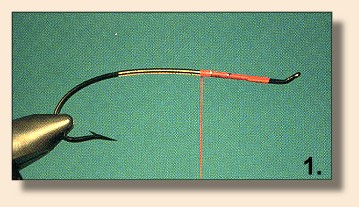
1. Secure a length of fine flat silver tinsel
just ahead of midshank. Wrap this tinsel
backward and then forward again, keeping each
wrap tight against the previous one but without
overlapping the wraps. Forming both the tag
and the silver underbody.
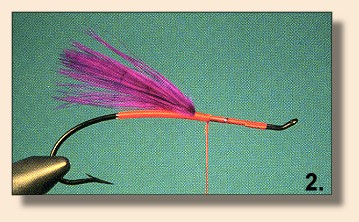
2. Wrap backward with the single-strand floss,
forming a thin butt. Leaving a turn or two of silver
tinsel showing for a tag, reverse direction
with the floss and wrap back to mid-shank. At
this point, secure a wing of purple marabou
fibers (use the entire tip section from a
marabou "blood plume") This "spike" of
marabou, when pulled to the rear, should extend
to the back of the hook bend.
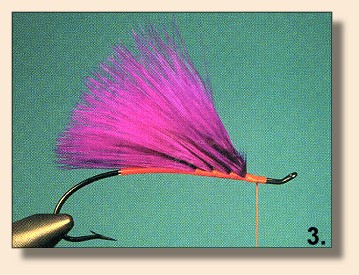
3. Tie in three more of these marabou spikes,
leaving a gap between the respective tie-down
points. Each successive spike must be cut
slightly longer than the previous ones so that
the ends are even at the rear.
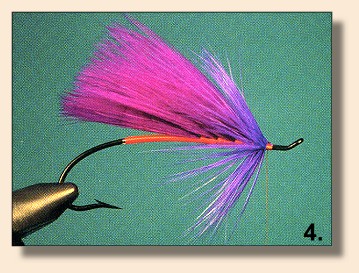
4. After securing the fourth spike of marabou,
switch to the fine thread and secure a
purple hackle. Make five or six turns of
hackle for a collar.

5. Now add a fifth spike of purple marabou
and then, if desired, add a long jungle cock
eye to each side of the wing. Then finish
the fly by making two or three turns of
orange-dyed guinea (use the long-fibered
rump feathers for large flies.) ~ John Shewey and Forrest Maxwell
Credits: From Fly Fishing for Summer Steelhead
published by Frank Amato Publications.
|

